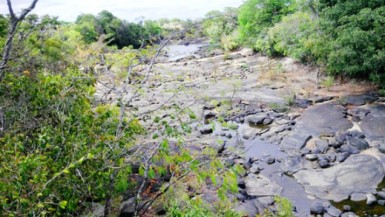Following months of drought, residents of North and Central Rupununi, in Region Nine, are breathing sighs of relief as the rainy season appears to have arrived.
“We have had about 10 days of rain,” Colin Edwards, owner of Rock View Lodge, told Stabroek News on Thursday. “The water table is still low but water is back in the wells.”

However, a resident of the South Rupununi, which has been the hardest hit by the drought, said there has been only two days of rain—on April 15th and April 23rd–which is not nearly enough to offer the residents relief from their prolonged water shortage.
Almost two weeks after Cabinet Secretary Dr Roger Luncheon announc-ed a plan for intervention by the Civil Defence Commission (CDC), its Director General Chabilall Ramsarup said yesterday that it is “now mobilising” the relief effort. “We are now mobilising and will be going in over the weekend,” he told Stabroek News.
He noted that they will mainly be taking supplies of water to the schools and villages in both North and South Rupununi, along with other supplies, such as tanks, pumps, bleach and water treatment tablets.
At a news conference yesterday, Luncheon said government has approved the release of funds for the CDC’s response to the situation. “Funding has been made available to procure pumps and tanks and the use of those facilities to transport water from the source to the communities and will continue until the rain comes to alleviate the problem,” he said.
He informed that at Tuesday’s Cabinet meeting, the drought was examined and a comprehensive report compiled by CDC was made available for analysis. The CDC assessment indicated that all three of Region Nine’s sub-regions have been affected by the drought.
He added that the government has been advised that the situation will continue into next month but noted that the weather patterns are being monitored by the Hydrometeorologi-cal Office and international weather stations.
The Guyana Relief Council, noting that potable water is very difficult to access for several villages in Region Nine, also announced yesterday that it has procured seven 430-gallon water tanks and 500 water treatment tablets. These items will be transported to the region through the auspices of the CDC, it added in a brief statement.
Daniel Gajie, head of the Rupununi Chamber of Commerce and Industry, said Lethem, which is in Central Rupununi, has been seeing rain “since last week, on and off.”
According to Gajie it will take about two to three weeks of rain to visibly raise the level of the Rupununi River, which had stopped flowing in some areas, but the situation is improving.
Lethem, he said, is receiving water through the pipelines although there may still be shortages in some of the villages and farms. He noted reports that the CDC was supposed to be assisting villages with sourcing water but could not comment on how that situation was progressing.
Gajie said he is optimistic about the situation. “Rain usually begins in this month. We would’ve had to worry if May had passed and we had no rain. A late May or June without any rain is a worry,” he said.
Stabroek News had previously reported that the drought in the Rupununi had led to water shortages, which were affecting domestic and commercial activities. Leaders and residents of the indigenous communities in the area had expressed concern at the rapidly declining water levels, which had resulted in several streams in the area drying out. These streams along with rivers and creeks are the main source of the untreated water used in the community. In addition, the low water table had resulted in the main crop cassava becoming “husky” as the soil around the tubers dried out.
At his post-Cabinet press briefing on April 10, Luncheon had described the state of affairs as “seasonal” even as residents warned that the situation was approaching levels not seen since 1998, when a state of emergency was declared because of the drought caused by the El Nino phenomenon in that year.
Luncheon had, however, noted that the government was putting in place measures to assist communities that were suffering. He announced then that Cabinet had instructed the CDC to coordinate responses that would be led by the Ministry of Amerindian Affairs, and include several ministries. (Thandeka Percival)





